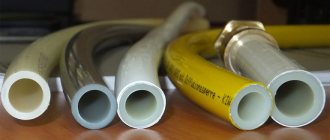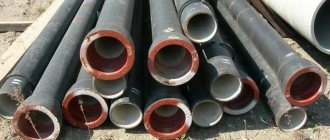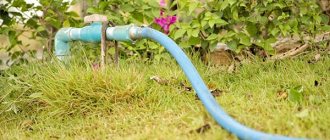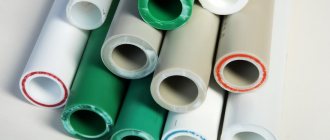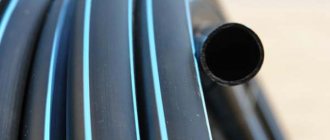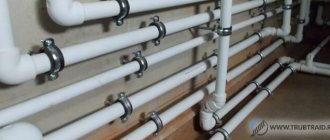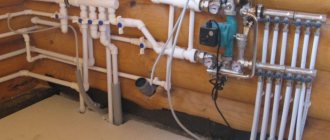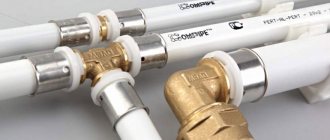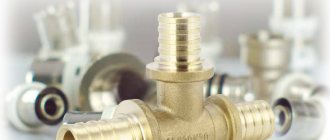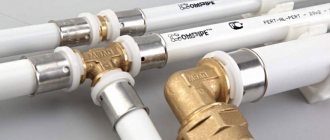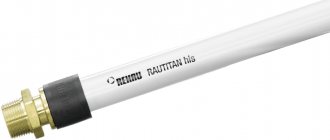The range of pipes for communication devices is extensive. The manufactured products differ significantly in their characteristics: material, flexibility, strength, durability. It is often difficult for the user to determine which pipe to choose for water supply to a house or apartment.
The type of pipeline and transported medium, the number of plumbing points in the network - all these are factors that tip the balance in favor of choosing one type or another.
In our material we will try to understand the subtleties of choice, and also tell you how to determine the optimal diameter of the pipeline.
No. 1. Steel pipes for water supply
Not so long ago, steel products were leaders in the field of organizing internal plumbing. No one even thought about which pipes for water supply were best to choose - steel ones were installed everywhere. The reason is simple - there were no alternatives. Today, when there is so much to choose from, the popularity of steel pipes has decreased, but there is still a demand for them.
Main advantages :
- low price. Steel pipes are practically the most affordable option for organizing a water supply system;
- high mechanical strength;
- ability to withstand temperatures up to 1000C, sudden temperature changes and pressure rises. That's why it's a universal option that is suitable for both cold and hot water supply.
Minuses:
- low resistance to corrosion, however, applying a zinc coating can somewhat slow down the formation of rust, but over time the protective layer wears off and the corrosion process starts;
- gradual overgrowing of the inner surface of the pipe, resulting in a decrease in throughput and deterioration in water quality. To extend its service life, the system will have to be periodically cleaned of accumulated deposits, but the choice of products should be approached with the utmost caution - alkaline ones, for example, will not work and will only aggravate the situation;
- complexity of installation. Installation is carried out either by welding or using threaded connections. In both cases, you cannot do without the help of a professional, if, of course, you want to get a sealed, reliable water supply system;
- high electrical conductivity of pipes.
With proper care, steel pipes can last about 40-50 years , but today they are used more for the reconstruction of existing water supply systems than for organizing new ones. If your choice falls on steel pipes, then pay attention to the thickness of the walls: there are light, ordinary and reinforced pipes. The thicker the wall, the more durable and reliable the product will be.
Recently, pipes have appeared on the market in which the inside is made of plastic. In a similar way, the problem of corrosion and overgrowth was solved while maintaining the strength properties of the steel. Such pipes have a somewhat limited scope of use - they are suitable only under the condition of a maximum temperature in the system of 750C and a pressure of 16 atm.
Plastic
Relatively recently, plastic pipes for water supply in an apartment appeared on the construction market, which have gained great popularity among ordinary consumers and have become number one among professionals. A number of advantages helped to achieve such success:
- Light weight. Thanks to this, they are easy to transport and do not create additional load on the walls. Their lightness allows them to be installed inside the wall, thereby hiding the unsightly structure from view;
- They are durable. The service life without repairs can reach 50 years;
- Low prices and a wide selection of fittings have made plastic products accessible to the majority of the population.
Plastic water pipe in the bathroom
*
When it comes to plastic products, we note that they are distinguished by composition and production method:
- polyethylene;
- polypropylene;
- PVC pipes.
Let's consider all the options.
Polyethylene
The first type is cross-linked polyethylene, which is produced using a special technology. Pipes made from this polymer are highly elastic and durable. At the same time, they have low thermal conductivity. They can be installed not only in the apartment, but also outside, as they are resistant to temperature changes.
Polyethylene does not change at the molecular level when heated and does not change its qualities, which makes them the best for creating heating and hot water supply.
Wiring with sewer outlet
They are a good material for creating plumbing structures in an apartment. The product can withstand water temperatures inside up to 95 degrees and this is not a chapel. Temperatures starting at 110 degrees can have a destructive effect on them, which is quite a lot.
The benefits include:
- Resistance of plastic to chemicals;
- Does not emit harmful substances and does not change the composition and taste of water;
- The inner walls do not retain dirt and buildup. Even after a long time there will be no stagnation;
- Thanks to their smooth structure, they have less resistance to water flow, which means less power is needed for compressors and boilers;
- Easy to install. They are easy to break or cut into required sizes;
- Polyethylene is resistant to vibrations and also absorbs the sound of water, which makes the water supply silent;
- Plastic. A structure made from such pipes is resistant to sudden temperature changes and does not deform even when frozen.
For apartments, the flexibility of the material is important, which allows for sewerage even in hard-to-reach places. The structure is installed using compression fittings.
If we talk about shortcomings, there are few of them. The negative side includes the flammability of the material and poor resistance to UV. But this does not affect the structure inside the apartment.
They are produced in diameters from 20 to 120 mm with a cross section of up to 40 mm. These are used for internal wiring, wider ones for risers.
Polypropylene products
If the budget for construction or replacement of an old water supply system is limited, you can create a structure from polypropylene pipes. They are considered the most affordable of all polymer products, but at the same time they are not inferior in quality. They can easily withstand temperatures of 95 degrees and pressures of 20 atmospheres. The service life of communications reaches 55 years.
It is worth noting a number of other advantages of this material:
- Resistance to chemical reagents allows you to obtain water without dangerous impurities;
- Does not corrode;
- They are easy to assemble and install into the required structure. Fasteners and fittings are affordable and can be easily purchased at any plumbing store;
- Low level of thermal conductivity avoids large heat losses;
- Not afraid of sudden temperature changes.
There are almost no disadvantages to this product. Problems usually arise not with the communications themselves, but with defects during their installation or assembly.
No. 2. Stainless steel pipes
To obtain a corrosion-resistant material, steel is alloyed mainly with chromium. “Stainless steel” looks great and has outstanding performance qualities. It is as durable as pipes made of ordinary and galvanized steel, withstands changes in pressure and temperature, and is not afraid of shocks. Moreover, such pipes are not afraid of corrosion , so the upper limit of durability exceeds 50 years. Among the main disadvantages is not even the complexity of installation, but the high cost of the material, which is why stainless steel pipes are used extremely rarely today, although they are excellent for hot and cold water supply systems.
No. 3. Copper pipes
Usually, they try to hide the water supply system in an apartment from view in every possible way, because there is little attractive in pipes and all kinds of fittings. This is true, but not in the case of copper pipes. They boast a unique appearance , so they can easily decorate a retro-style interior. Appearance is not the only advantage of this type of pipe, among other advantages:
- high resistance to temperature deformation;
- durability up to 70 years;
- resistance to high temperatures and increased pressure in the system;
- corrosion resistance and less tendency to overgrow compared to steel pipes;
- Completely safe for health, as no hazardous compounds are formed when chlorine interacts with copper. Moreover, copper pipes have a disinfecting effect and rid water of pathogenic bacteria. Unlike steel, copper does not spoil the taste of water.
Among the disadvantages :
- high price and small range. Everything that is on the market today is mainly products of foreign manufacturers. In addition, there are problems with finding the necessary fittings for installing pipes;
- complex installation using soldering;
- low mechanical strength
If you choose which pipes for water supply are better, then copper ones can easily compete for the title of winner, but their high cost still does not allow them to become a leader in this area. Where hidden installation of water supply is not possible, copper pipes can be a very good option.
Types, properties and scope of application of pipes for internal and external water supply
| Pipe material | Properties | Application area | Installation methods | Service life, years |
| Metal pipes | ||||
| Steel | Corrosion resistant, heavy, high thermal conductivity | Water supply and sewerage pipelines | Couplings, elbows, fittings, welding | 30–40 |
| Cast iron | Large wall thickness; less susceptible to corrosion than steel; heavy, resistant to temperature changes, durable, non-emergency | Water supply and sewer networks, rain and sewage drains | Sealing gaskets and sockets | 80–100 |
| Copper | Low corrosion, reliable, withstands temperature changes, the thermal conductivity of copper is 4 times higher than that of steel; resistant to UV rays; impermeable to gases; have a bactericidal effect; operating temperature range from –200 to +500 °C; not subject to aging. Over time, they become covered with a thin layer of oxide, which does not affect their strength. | Pipelines for heating systems, cold and hot water supply, oil pipelines, gas pipelines | Capillary high-temperature soldering, fittings | 50–70 |
| Plastic pipes | ||||
| Polybutylene | Elasticity, thermal conductivity, maximum operating temperature +82 ° C, susceptible to UV rays, freezing resistant | Warm floor | Fitting | 45–50 |
| Polyethylene | Elasticity, strength, frost tolerance, increased sensitivity to UV rays. Melts at high temperature | Cold water supply | Welding | 50 |
| Cross-linked polyethylene | High strength, high temperature resistance, oxygen conductivity | Internal water supply, heating external gas and water supply systems. The scope of application is very wide | Metal crimp couplings | 50 |
| Polyvinyl chloride (PVC) | Non-flammability, lightness, resistance to UV rays | Drinking water supply, construction of water technical structures (swimming pools) | Gluing | 50 |
| Polypropylene | Elasticity, tightness, strength, resistance to high temperatures | Cold and hot water supply, sewerage, heating | Welding | 50 (in cold water supply), 25 (in hot water supply) |
| Metal-plastic | Elastic, aesthetic, lightweight and durable, able to withstand temperature loads of +95 °C, short-term - up to +110 °C | Water supply and heating | Fitting | 50 |
No. 4. Metal-plastic pipes
Looking ahead, we note that metal-plastic pipes are an excellent option for organizing water supply for a summer house or private home . The product has a multilayer design: around a layer of aluminum foil there is an outer and inner layer of plastic. They are fastened together with strong glue. The metal layer provides the necessary strength, and the plastic provides lightness, flexibility, and resistance to corrosion and overgrowth.
Advantages:
- low price;
- durability about 35 years;
- corrosion resistance;
- mineral deposits do not accumulate inside such a pipe, so there is no need for regular cleaning;
- light weight. A pipe 10 m long and 30 mm in diameter weighs about 1-2 kg;
- simple installation, which is carried out using press fittings and a wrench - no welding;
- flexibility and ability to maintain shape;
- dielectric outer shell.
Minuses:
- From time to time you will have to tighten the threaded connections, so it is necessary to ensure easy access to them. The reason that the joints weaken is simple - aluminum contracts more than plastic when the temperature changes;
- connecting elements do not have a budget price;
- not the best strength of the joints, and even the pipes themselves.
Metal-plastic can withstand temperatures up to +950C at a pressure of 10 atm . The pipes will maintain their integrity with a short-term increase in temperature to +1100C at constant pressure. The material will also withstand pressure increases of up to 25 atmospheres at temperatures up to +250C.
To equip a cold water supply , you can take blue and light blue pipes - they are adapted to operate at water temperatures no higher than +350C and are cheaper than white pipes, which can be used to transport hot water . This is a very good option for a dacha and a private house, but for an apartment building you can choose more suitable pipes.
What you need to know about metal-plastic
Metal-plastic pipes for hot water are installed very often. The reason for this is the following factors:
- More affordable cost and long time that these products can be used.
- Simple installation work, which does not require the purchase of expensive professional equipment. Possibility to do the installation yourself.
- Excellent operating characteristics.
- Low thermal conductivity, which means heat loss is kept to a minimum.
Select pipes for heating your home.
Each master, answering the question of which pipe materials are better to choose, polyethylene or metal-plastic, will note that the use of this assortment has the following disadvantages. The joints on compression fittings are not as reliable and durable. Therefore, when arranging a pipeline, it is better to use press fittings.
No. 5. Polyethylene pipes
Pipes made of polyethylene, polypropylene and polyvinyl chloride are often combined into the general group of plastic pipes. Despite the similarity of some characteristics, each of these materials has a set of unique properties, and we will begin by considering polyethylene structures.
Let us note right away that it is necessary to separate pipes made of low-density polyethylene and cross-linked polyethylene. They are characterized by temperature resistance. The former can withstand temperatures of no more than +400C, are suitable for organizing cold water supply, and are often used to transport water from a well to a private home, since they are not afraid of frost and do not burst when water freezes.
Pipes made of cross-linked polyethylene can be used in a hot water supply system, but they are also more expensive. No rubber seals are used for installation - the required degree of tightness is achieved by crimping the fitting with a pipe.
A number of experts call cross-linked polyethylene pipes the best option for organizing water supply. They are resistant to corrosion, do not overgrow, are inert to all substances contained in water, and allow you to create strong connections. The disadvantages are not the lowest price and the need for special equipment for installation.
No. 6. Polypropylene pipes
Polypropylene pipes are actually an ideal option for organizing water supply . Can be unreinforced or reinforced . The former are suitable only for cold water supply, the latter are used for both heating and hot water supply. The pipe can be reinforced with aluminum, fiberglass or other materials. Reinforcement increases strength and reduces thermal elongation of polypropylene. The best option is fiberglass reinforcement.
Polypropylene pipes for water supply
Today, the highest quality reinforced pipes are produced in Germany. Detailed technical characteristics and a list of objects where such pipeline systems are installed can be found on the website of the representative of the German plant aquatherm GmbH - Agpipe Group of Companies: https://agpipe.ru/plastikovie_trubi_dlya_vodoprovoda/polipropilenovie_trubi_dlya_vodosnabzheniya
Advantages of polypropylene pipes:
- durability up to 50 years;
- the ability to withstand temperatures inside pipes up to +90-950C and pressure up to 20 atmospheres (this applies to the reinforced version);
- relatively easy installation. The pipes are connected using a special welding machine for polypropylene. Working with it is not difficult; it will take a little time to learn and bring the process to automation;
- strong connections;
- such pipes will even withstand freezing of water inside them;
- corrosion resistance;
- sufficiently high strength;
- relatively low price
Among the disadvantages is the fear of high external temperatures, so this is not an option for fire hazardous areas. In addition, even when reinforced with aluminum or nylon thread, the material retains a high level of thermal deformation, so the use of insulation for hidden pipe routing, or compensators for open routing, is indispensable. If you weigh all the pros and cons, then it is better to choose polypropylene pipes for water supply at home.
Types of fittings and connecting elements of water pipes
| Name | Appearance | Application area |
| Coupling for connecting pipes of different diameters | For connecting different sections of a water supply system, two sections of a pipe, a sleeve, a hose without changing the direction of the pipe. This part matches the diameter and material of the pipes being connected. The main function is a sealed connection | |
| Coupling for connecting pipes of the same diameter | ||
| T-fitting | Connects three pipes to each other, with one pipe branching away from the other at an angle of 90° | |
| Square | To connect pipes that approach each other at right angles, thus changing the direction of the pipe. Deflection angle is 90° or 45° | |
| Cross fitting | Used to branch pipes in 4 directions, has 4 outlets located at an angle of 90° to each other | |
| Knee | To connect pipes into a single circuit | |
| Threaded connection | For connecting water pipes with threads |
In conclusion, according to the already established tradition, some interesting videos about water pipes:
At a special stand, the tensile strength of plastic water pipes from different manufacturers is measured.
These articles may also be of interest to you:
- Methods for protecting water pipes from freezing
- Soldering copper pipes. Soldering restoration
- Ensuring safety during plumbing work
- Errors in organizing water supply and sewerage
What else would you like to read?
Tags: types of water pipes, types of pipes, water pipes, flexible plumbing, copper pipes, metal pipes, metal-plastic pipes, plastic pipes, polybutylene pipes, polypropylene pipes, polyethylene pipes, steel pipes, polyvinyl chloride (PVC) pipes, cross-linked pipes polyethylene, fittings, cast iron pipes
No. 7. PVC pipes
PVC pipes are used only for cold water supply, can withstand temperature surges up to +650C , pressure up to 16 atmospheres , are often used for supplying water to the house, but rarely for internal wiring.
Among the advantages :
- resistance to aggressive environments;
- low weight;
- resistance to corrosion and overgrowth;
- fire resistance;
- durability about 50 years;
- Relatively simple installation; high tightness of connections.
Among the disadvantages , in addition to instability to high temperatures, it is worth noting the sensitivity to scratches and the difficulty of disposal.
How to determine the required pipe size?
To conveniently determine the diameter of pipes and fittings and link them to all elements of the system, use the value of the internal diameter ( Dy is the nominal diameter of the pipes). They focus on typical sizes of steel pipes - they are produced with Dy - 15 mm, 20 mm, 25 mm, 32 mm.
The length of the supplied steel pipes can be different, mainly these are sections from 4 to 12 m long. Metal-plastic pipes can have a diameter (Dy) of 16-30 mm and a wall thickness of 2-2.5 mm.
Metal-plastic and plastic pipes are supplied to wholesale and retail chains in coils or in lengths. The total length of the products should be with a margin - 2-5% longer than provided for in the project (if this margin was not initially included in it)
The choice of the diameter of the future pipeline depends on the following factors:
- Water pressure in the network. The lower it is, the larger the diameter should be. A thin pipe with insufficient pressure will produce only a thin stream of water.
- Pipeline lengths. The greater its length, the lower the pressure in the network and, accordingly, it is necessary to use a larger diameter.
- Number of turns and joints. Each such element reduces pressure. By choosing pipes with a large diameter, it is possible to increase the flow of water into the house.
These factors are related to the properties of the pipeline itself. In addition to them, the water temperature, parameters of pumping equipment and much more are taken into account.
There are special formulas for accurately calculating the diameter, but the general rule when purchasing is not to incline your choice in favor of saving by reducing the diameter of the pipe.
In a narrow pipeline, more hydraulic losses occur, which will have to be compensated for by a more powerful pump and more electricity required to operate it, and this is an additional expense.
When installing a pipeline in an apartment, most often there is no need for calculations - there is already wiring at the entrance. Its dimensions are known, they are designed for the required water flow. Usually, before entering the apartment, the common pipeline is installed from pipes with a Dy of 20-32 mm; for apartment wiring, pipes with a Dy of 15-20 mm are used.
The diameter of polymer pipes may vary among different types. But since the pipeline entry into an apartment is, as a rule, made of steel, when producing polymer products, manufacturers often focus on the possibility of connecting them to pipes with standard values
